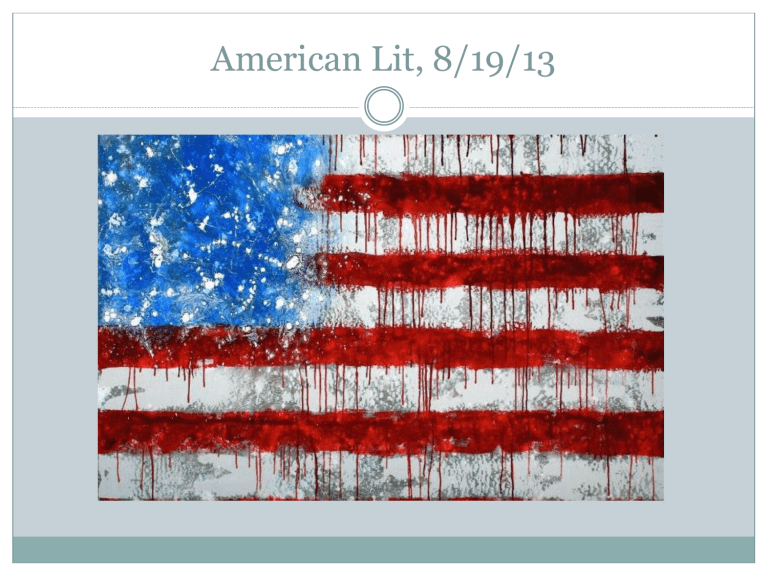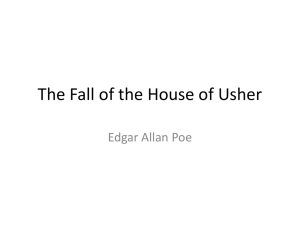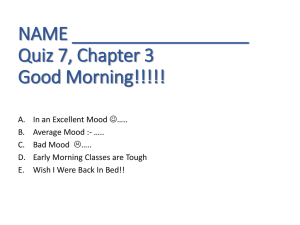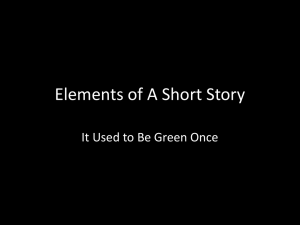American Lit, 8/19/13 - Mr. B's American Lit Classes

American Lit, 8/19/13
Opening
“Indeed, it strikes me that to lay this obscenity off to some mitigating factor, no matter how worthy, is to make the crime smaller than it is and offer rationalizations that insult the sufferers.
Meaning that I don’t care what video games these wretches played. Don’t give a damn if they were picked on by other kids.
It makes no difference.
1.
2.
-
This was a special category of evil.”
Leonard Pitts, Jr., writing about the young men who committed the Columbine HS massacre
What is Pitts’ attitude toward the perpetrators of the Columbine massacre? How do you know?
In the second paragraph, Pitts uses two incomplete sentences. How does this contribute to his overall tone and purpose?
Opening
-
“Twenty bodies were thrown out of our wagon. Then the train resumed its journey, leaving behind it a few hundred naked
dead, deprived of burial, in the deep snow of a field in
Poland.”
Elie Wiesel, Night
1.
2.
This scene describes the transporting of Jews from
Auschwitz to Buchenwald, both concentration camps in
WWII. In this selection, Wiesel never refers to the men who die on the journey as men. Instead they are bodies or simply
dead. How does this use of diction shape your understanding of the situation?
How would the meaning change if we substitute dead people for bodies?
Essential Question
“How can we learn from the way in which an author structures his/her story?”
The Five-Act Plot Structure
Key Vocabulary
Plot – The main, overall story of a work of fiction.
Exposition – The introduction to the characters and their world. Necessary background is given, characterization and relationships are established.
Rising Action – The conflict is introduced. Tension heightens.
Key Vocabulary
Climax – The most important part of the story; NOT the end of the story. Usually in the climax, the protagonist make a fateful decision that determines the outcome of the story. After the climax everything is different and you should have some sense of how the story will end.
Falling Action – The part of the story immediately following the climax. If the results of the climax were not already apparent, then they are now.
Resolution – The end of the story. The conflict is resolved and the fates of all characters are clear.
Opening
-
1.
2.
“Her face was white and sharp and slightly gleaming in the candlelight, like bone. No hint of pink. And the hair. So fine, so pale, so much, crimped by its plaiting into springy zigzag tresses, clouding neck and shoulders, shining metallic in the candlelight, catching a hint, there it was, of green again, from the reflection of a large glazed cache-pot containing a vigorous sword-leafed fern.”
A.S. Byatt, Possession: A Romance
When Byatt describes a face “like bone,” what do you picture? What feelings do this generate for you, the reader?
How can hair be “clouding neck and shoulders?” What does that mean? How do you picture that image?
“To Build a Fire” by Jack London
The story is on pg. 620.
As we read the story, complete the day’s handout
(Burke’s ‘Plot Notes’ graphic).
Decide which parts of the story are the exposition, rising action, climax, falling action, and resolution.
Also, for the beginning, middle, and end of the story explain what you think is most important and why.
“To Build a Fire” by Jack London
1.
2.
3.
4.
5.
What advice from the old-timer does the man choose to ignore? What can you infer from this about the man’s character?
What do the dog’s instincts tell it about the cold? Why does the cold make no impression on the man?
In the rising action, what traps does the man try
(unsuccessfully) to avoid? When he’s unable to avoid the traps, what chain of events is set into motion?
What is the climax of the story? It what ways does the climax determine the story’s outcome?
Do you think the outcome of the story is mostly due to fate or the man’s own character? Explain.
Closing
3-2-1 regarding today’s lesson.
3 = Things you learned today.
2 = Things that are still unclear to you.
1 = Question.
Complete the closing on a half sheet of paper.
Opening
-
“He went on till he came to the first milestone, which stood in the bank, half-way up a steep hill. He rested his basket on the top of the stone, placed his elbows on it, and gave way to a convulsive twitch, which was worse than a sob, because it was so hard and dry.”
Thomas Hardy, The Mayor of Casterbridge
1.
2.
How do the details in this passage prepare for the
convulsive twitch at the end of the passage?
This excerpt does not describe the character’s face at all. What is the effect of this lack of detail for the reader?
Essential Question
“How do authors use setting to create mood?”
Key Vocabulary
Setting – Where the story is set (duh).
Includes not only the geographic location, but also the time and mood.
Mood – The atmosphere that pervades a work of lit. Or, the feeling that we the reader get from a work of lit.
In plays and movies, the physical sets and the music contribute to the mood.
We use adjectives to describe mood.
Mood is distinct from tone (more on that later).
Mood in Film
Clip #1 – Dracula. 1931, Browning.
Clip #2 – The Shining. 1980, Kubrick.
Clip #2 – Blade Runner. 1982, Scott.
Clip #3 – The Princess Bride. 1987, Reiner.
Mood In Literature
Together, we will read James Baldwin’s “The
Rockpile.”
Pay particular attention to Baldwin’s descriptions of the story’s setting.
Locate five notable descriptions of the setting and, using strong adjectives, describe the mood the descriptions conjure.
Mood in Literature
Together, we will read Edgar Allan Poe’s “The Fall of the House of Usher.”
Pay particular attention to Poe’s descriptions of the story’s setting (Usher’s mansion).
Locate five notable descriptions of the setting and, using strong adjectives, describe the mood the descriptions conjure.
“The Fall of the House of Usher”
1.
2.
3.
4.
a) b) c)
In Poe’s initial description of Roderick Usher’s house, which words suggest the presence of decay in the house itself?
In what ways does the description of the house foreshadow the end of the story?
Which details in the description of Roderick Usher’s appearance suggest he has been shut off the from the world and decayed in much the same way as the house?
Briefly describe the way in which each of the following contribute to the overall mood of Poe’s story:
The description of the house.
The description of Madeline’s entombment.
The storm that occurs near the end of the story.
Opening
-
1.
2.
“If my mother was in a singing mood, it wasn’t so bad. She would sing about hard times, bad times, and somebody-done-gone-andleft-me times. But her voice was so sweet and her singing so melty I found myself longing for those hard times, yearning to be grown without “a thin di-I-me to my name.” I looked forward to the delicious time when “my man” would leave me, when I would “hate to see that evening sun go down…” ‘cause then I would know “my man has left this town.” Misery colored by the greens and blues in my mother’s voice took all of the grief out of the words and left me with a conviction that pain was not only endurable, it was sweet.”
Toni Morrison, The Bluest Eye
What are the parts of the excerpt in quotes? What are they quoted
from? What do they add to the passage?
Why does Morrison’s narrator say that “pain…was sweet”? How does the author set this statement up?
Theme Statements
Use this structure for all future theme statements:
The short story/novel/poem title of the poem by name of the author is about pick a topic related to the story and reveal that state the author’s attitude about the topic .
Relationships, war, love, death, human nature, and religion are all common topics in novels, short stories, and poems. There are, of course, many more.
The short story “Ambush” by Tim O’Brien is about war and reveals that war makes even good people do bad things .
Key Vocabulary
Theme – A universal statement about life made by a work.
Themes should be written as statements (that is, complete sentences). They are not one word!
They should be based on the work being studied/written about, but also be broad enough to apply to other works.
Themes are not always lessons. There are
ideas, though, that the authors want us to understand.
A Skit
Mr. B : Okay class, what’s the theme of Tim O’Brien’s story “Ambush”?
Student : War.
Mr. B : That’s not a theme, that’s only one word.
Student : Gosh darn it!
Mr. B : No, no. Back up. You’re right, it is a story about war.
Student : Okay…
Mr. B : Does O’Brien make war look like a good or a bad thing?
A Skit
Student : Well, he talks about how the things he did in war still bother him today…so I guess, bad?
Mr. B : Right on! Okay, so let’s turn that into a sentence.
Why does O’Brien think war is bad?
Student : …Because it makes good people do bad things?
Mr. B : Bingo! Okay, let’s write it as a theme statement…“Ambush” by Tim O’Brien is about…
Student : War.
Mr. B : …And reveals that…
Student : War makes good people do bad things.
Mr. B : Awesome!
Aesop’s Fables
You and your partner will be given one fable (that’s the genre) by Aesop (that’s the author).
Read your fable carefully.
Determine a topic in the story (some of them have multiple topics).
Determine what Aesop wants us to understand about that topic (there might be multiple things at once).
Write a theme statement for your fable including all of the above info.
The short story/novel/poem title of the work by name of the author is about pick a topic related to the story and reveal that state the author’s attitude about the topic .
Homework
Read “Everyday Use” by Alice Walker.
Study for your vocab quiz!
Reading Quiz #2
1.
2.
3.
How does the narrator know Roderick Usher?
Briefly describe the nature of Usher’s illness.
Name one of the two things that the narrator remarks are unusual when gazing upon Usher’s “deceased” sister, Madeline.
4.
5.
How does Usher die at the end of the story?
What happens to the house of Usher at the end of the story?
BONUS #1: What clues are there throughout the story that the narrator might not be entirely reliable? Name one.
Bonus #2: What is the story about that the narrator reads
Usher during the story’s falling action?
Opening
Let’s revisit the stories we’ve read so far…
So far we’ve read “Ambush,” “Marigolds,” and “To
Build a Fire” (all in the textbook).
Pick ONE story and explain, in writing and with examples, how the story exemplifies some part of
American culture or history.
What about the story makes it uniquely American?
Homework
Read Julia Alvarez’s story “Antojos.”
Anticipate a possible reading quiz.
Essential Question
“What makes both Walker’s “Everyday Use” and Alvarez’s “Antojos” quintessentially
American short stories?
In what ways do these two stories expand our understanding of what make a story
American?
“Antojos”
Complete Burke’s “Story Notes” for Alvarez’s short story.
For character, make sure you describe how the author characterizes whomever you consider the main character.
Describe the story’s mood under setting.
Write both a theme statement for the story and the p.o.v. from which the story is told under the section called “Observations/Conclusions.”






